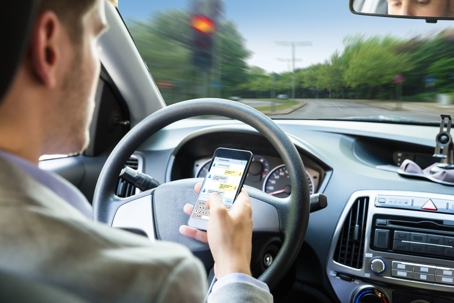There’s been a lot of discussion about distracted driving in the past few years. Most often, the conversation revolves around texting while driving, but that’s just one symptom of a much larger problem. That’s because these crashes aren’t caused by any single action; they’re a pattern of behavior born from the three different types of distracted driving.
Most government safety organizations, including the CDC, have identified three distinct types of distracted driving, each affecting a different aspect of your driving ability. These categories are:
Manual Distractions
You indulge in a manual distraction any time you take your hands off the steering wheel. Reaching for food, the radio, or anything else in the car may seem simple, but it significantly slows your reaction time and makes you more likely to fall into the other two types of distracted driving.
Common forms of manual distractions are:
- Eating
- Adjusting the radio or AC
- Applying makeup
- Assisting children or others in the backseat
- Holding a phone
However, there is some evidence that additional manual interaction may increase focus when the action relates to driving. One study found that drivers operating manual transmission vehicles were far more likely to stay focused and make fewer driving errors as operating the stick shift required constant attention.
Visual Distraction
A visual distraction is anything that takes your eyes off the road. That means looking at your phone while driving is just as distracting as looking at a billboard or rubbernecking to stare at an accident. Visual distractions are most dangerous at high speeds.
For example, if a driver is traveling at 55 mph and they look at their phone for two seconds, they will have traveled 160ft. In that time, the car ahead of them might slam the brakes, or an animal might jump into the road. If you’re not paying attention, you won’t have time to hit the brakes and either prevent the crash.
Cognitive Distractions
A cognitive distraction is anything that causes you to lose focus or shift focus away from driving. It may be listening to your favorite music, coming up with a response to your passenger’s conversation, or thinking about all the things you need to do when you get home. These factors are very different, but they all draw away from your mental focus just the same.
Cognitive distractions are insidious. More often than not, someone engaging with a cognitive distraction won’t realize they’re distracted at all until either they snap out of it or they end up in a crash. If you’ve ever found yourself daydreaming while driving or losing track of your commute, you fell into a cognitive distraction.
Triple Threat Driving Distractions
When a single distraction includes all three types of distracted driving, we call that a “triple threat.” These distractions take your hands off the wheel, your eyes off the road, and your mind away from driving at the same time.
Triple threats are more prevalent than you may realize. Think about some of the most common driving distractions: Texting and driving, eating and driving, and even talking to a passenger. Each of these draws your attention, your eyes, and your hands away from driving and toward something else. And that feedback plays into itself.
Say you want to do something as simple as adjusting the heat. You first expend cognitive power to realize you’re cold. Then you look at the control knobs, a visual distraction, and decide how hot you want it. You adjust the knobs (a manual distraction) and shortly realize it’s a little too hot and you’re uncomfortable (another cognitive distraction). Now the process starts over again until you find the perfect temperature.
That’s just one example of a triple threat, and the more time you spend on these distractions, the more likely you are to be involved in a serious crash.
Were You Injured By a Distracted Driver?
Nine people in the United States are killed every day in an accident that was directly or indirectly caused by a distracted driver. If you or someone you loved was harmed in a distracted driving accident in Connecticut, the experienced team of personal injury lawyers at RisCassi & Davis, P.C. is here to fight for you. Our board-certified attorneys have recovered over half a billion dollars for clients over the past 65 years in practice, and we're ready to help you too!
Have you or someone you love were seriously injured by a distracted driver? For help from our Connecticut accident attorney from RisCassi & Davis, P.C. don’t hesitate to call us at (860) 245-2412 or contact us online!

